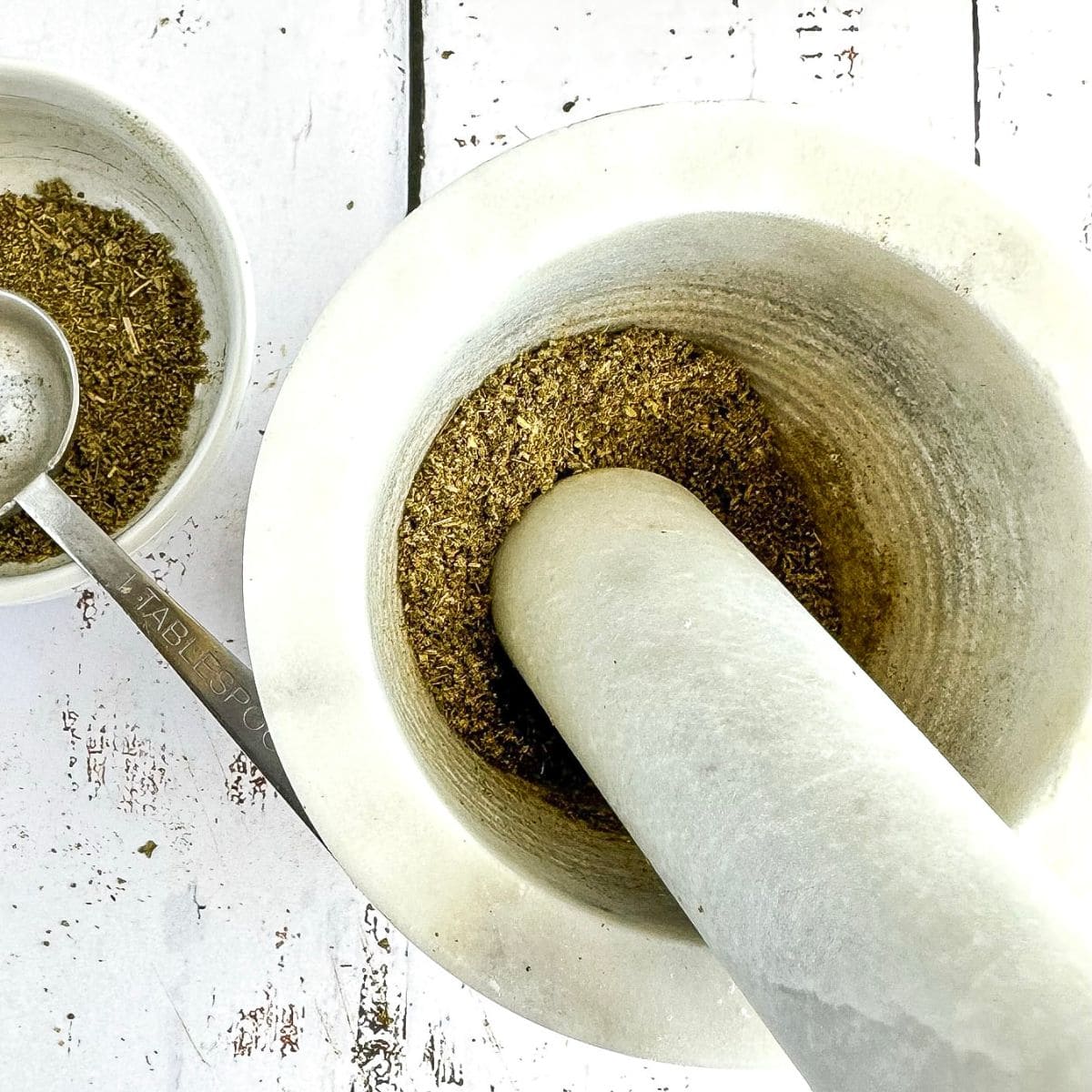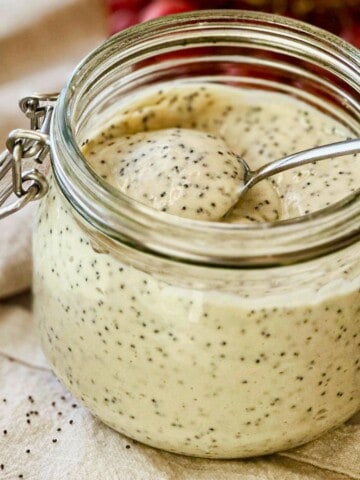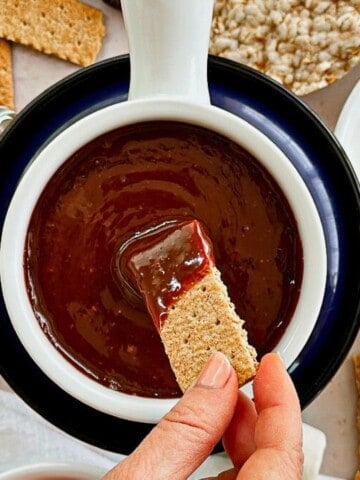Whip up a simple homemade Italian seasoning substitute using a blend of dried herbs, and you'll effortlessly evoke the authentic flavors of classic Italian cuisine. Looking for more options? We have some other ideas too.

Italian seasoning is more than just a combination of herbs. It's the soul of many Italian dishes, evoking the warmth and richness of Mediterranean cuisine. But what if you run out? We've got some ideas.
For more delicious seasoning blends to use in your plant-based recipes, check out Adobo Seasoning, Creole Seasoning Recipe, Homemade Taco Seasoning, or Bijol Traditional Latin Seasoning Condiment. Explore more variety at 20 Seasoning Blends.
Jump to:
What's in Italian seasoning?
Though named 'Italian seasoning,' this blend isn't traditionally used in Italy. It's more of a Western creation to encapsulate the essence of Italian flavors. In Italy, chefs prefer using fresh herbs and seasoning dishes individually.
Ingredients to make your blend
See the recipe card for quantities. The quantities can be modified to suit your preference. If you don't have one of the spices, it's fine. You will still get a great Italian taste in your dish.

Truly, the best way to substitute Italian seasoning is to recreate it with individual herbs. You maintain control over the flavor and can adjust each herb's presence to match the dish's needs. Here's a standard blend that you can modify as needed:
- Oregano: Your base, earthy and robust
- Basil: For a sweet touch
- Thyme: A hint of minty freshness
- Rosemary: For that piney accent
- Marjoram: Adds a sweet, floral note
- Sage: For warmth and complexity
Instructions
- In a small bowl, combine all the dried herbs and spices
- Mix well to ensure an even distribution of the herbs and spices.
- Store the homemade Italian seasoning substitute in an airtight container.
If you're working with whole spices, you'll need something to grind them down. An electric grinder works great, or you can go old school with a mortar and pestle. The mortar gives you more control over the texture and is quite satisfying!

Combine all spices into a grinder and grind until desired consistency.

Alternatively, combine all spices in a mortar. Using a pestle, grind them until they reach the desired consistency.
Other options
If minimal seasonings are available, you can still add flavor to your dishes using a few basic ingredients.
The "best" substitute can be subjective and vary depending on your cooking and the flavors you want to emphasize. However, I'll present you with strong contenders you can choose from.
Here are some ideas for substituting Italian seasoning with minimal seasonings:
- Individual Dried Herbs: If you have dried herbs, such as basil, oregano, or thyme, you can use them individually or in combination to enhance the flavor. These herbs are commonly found in Italian cuisine and will add a touch of freshness to your dishes.
- Herbes de Provence: This French herb blend often includes some of the same herbs found in Italian seasonings, like thyme and rosemary. It might also include lavender, which can add an interesting twist.
- Greek Seasoning: This blend has oregano, garlic, lemon peel, and sometimes mint. It can work in some dishes.
- Vinaigrette with Garlic and Lemon: In some recipes, like salads, a flavorful vinaigrette with garlic, lemon, olive oil, and maybe a touch of mustard can replace the need for Italian seasoning altogether.
- Fresh Herbs (if available): If you can access fresh herbs like basil, parsley, or rosemary, you can use them instead of dried herbs. Fresh herbs tend to have a stronger flavor, so use them sparingly.
- Poultry Seasoning: This blend could work as it typically includes sage, thyme, marjoram, and sometimes rosemary. However, it sometimes has a little nutmeg, so the flavor of your dish may vary a bit. The blends vary, so check the ingredients before adding them.
- Fines Herbes: A more delicate French blend, including chervil, parsley, chives, and tarragon. It might be a nice touch in lighter dishes like salads or seafood.
- Fresh Herbs: If you can get fresh basil, oregano, and thyme, combining these can create a vibrant and lively flavor different from dried herbs.

Remember, while these substitutions may not replicate the exact flavor of Italian seasoning, they can still add some depth and taste to your dishes.
While substitutes like Herbes de Provence or simple oregano could work in a pinch, creating your blend of Italian seasoning gives you the ultimate control over the flavor profile. It's like being a maestro, conducting a symphony of herbs in your kitchen.
Using Italian Seasoning in Cooking

Italian seasoning is delicious in all sorts of dishes!
- Pizza: As a pizza lover, adding Italian seasoning to your homemade pizza will elevate the flavor. Try it on this Biga Neopolitan Pizza Dough Recipe.
- Pasta Sauces: Italian seasoning complements all types of sauces. Try it in this Neopolitan Pizza Sauce Recipe.
- Roasted Vegetables: A sprinkle of this blend makes veggies irresistible.
- Tofu or Tempeh: It adds depth and character.
- Bread: A touch of Italian seasoning in your dough will make your homemade bread extraordinary.
- Roasted Chickpeas Croutons - Add some Italian seasoning for variety.
- Homemade croutons or breadcrumbs - A tasty twist for added variety.
- The Best Vegan Lasagna - Italian seasoning is delicious in this ricotta.
Variations
Add a teaspoon of garlic powder, onion powder, and red chili flakes for the perfect pizza blend. It'll give your pizza that irresistible flavor boost. Try the blend on this Neopolitan Pizza.
For a zesty Italian seasoning, throw in a dash of cayenne pepper or red chili flakes for that extra kick.
Add 1 teaspoon dried lemon or orange zest for a citrus twist.
For a Mediterranean taste, add 1 teaspoon of dried lavender.
Storage

Store your Italian seasoning in an airtight container, away from heat, moisture, and direct sunlight, to keep the flavors fresh and vibrant.
Top tip
Use as many of the herbs in the recipe as you can but if you're missing some, you will still get a delicious spice blend you can use.
FAQs
Generally, you can use the same amount of your substitute as the Italian seasoning called for in the recipe, but you may need to adjust to taste.
Even a blend of just a few of the herbs (like oregano and basil) can do the trick. Feel free to experiment.
The flavor may vary slightly depending on the substitute, but if you stick to Mediterranean herbs, the overall profile should remain fairly consistent.
What did you think?
So, you gave this paella recipe a whirl, eh? We're all ears – or eyes, in this case! Rate it with stars - think of it as giving our paella a Michelin rating. Was it a one-star "pretty good" or a five-star "I loved it." And don't forget to leave a comment. I love to hear from you. Follow us on Instagram, Facebook, and YouTube for inspiration.
PrintRecipe

Homemade Italian Seasoning
This delightful homemade Italian seasoning is an excellent blend for all those Italian flavors you want. Perfect for pasta, pizzas, and more.
- Total Time: 3 minutes
- Yield: 7 tablespoons 1x
Ingredients
- 2 tablespoons oregano
- 2 tablespoons basil
- 1 tablespoon thyme
- 1 tablespoon rosemary
- ½ tablespoon marjoram
- ½ tablespoon sage
Instructions
- If you like your Italian seasoning a little finer, grind the dried basil, oregano, rosemary, marjoram, thyme, and sage in a spice grinder or use a mortar and pestle. If you prefer a more rustic texture, you can skip this step.
- In a small bowl, combine the herbs.
- Give the mix a taste and adjust the proportions to suit your preferences. Need more spice? Add a pinch more red pepper flakes. Want it more earthy? Add a bit more sage or thyme.
- Transfer your Italian seasoning into an airtight container. Keep it in a cool, dark place, and it should stay fresh for up to six months.
Notes
If you are missing any spices for the recipe, it's ok. You're seasoning blend will still add an authentic Italian taste to your dish.
Store in an airtight container to maintain freshness.
- Prep Time: 3 minutes
- Category: condiment
- Cuisine: American, Italian-Inspired
Nutrition
- Calories: 7
- Sugar: 0.1
- Sodium: 1
- Fat: 0.2
- Saturated Fat: 0.1
- Carbohydrates: 2
- Fiber: 1
- Protein: 0.3





















Ben says
Never buying pre-made again.
Regi Pearce says
I'm so thrilled to hear that you found the Italian blend substitute so easy and effective that you're planning on sticking with homemade from now on.